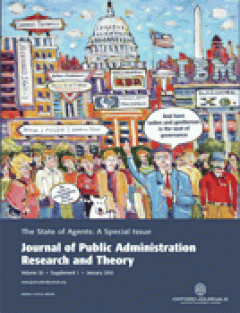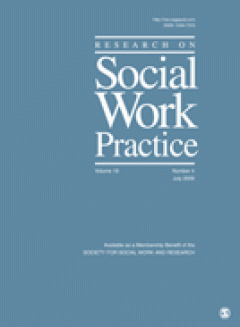Filter by

Does Cross-Sectoral Partnership Deliver? An Empirical Exploration of Public S…
Cross-sectoral partnerships are increasingly seen as a solution to the most pressing social problems facing contemporary societies. Sectoral rationales for partnership suggest that public, private, and nonprofit organizations each possess distinctive advantages that can enhance the effectiveness, efficiency, and equity of public agencies’ efforts to address social issues. We present an explorat…
- Edition
- Vol. 20 No. 3. July 2010. pp. 679-701
- ISBN/ISSN
- 10531858
- Collation
- -
- Series Title
- Journal of Public Administration Research and Theory
- Call Number
- -

Stability and Punctuations in Public Spending: A Comparative Study of Budget …
This article provides a comprehensive analysis of stability and punctuations in public spending within and across two different countries—Denmark and the United States. The theoretical starting point is the classic model of budget incrementalism and Jones and Baumgartner's model of disproportionate information processing. First, despite the clear differences in institutional setup, we show that…
- Edition
- Vol. 20 No. 3 July 2010.pp. 703-722
- ISBN/ISSN
- 10531858
- Collation
- -
- Series Title
- Journal of Public Administration Research and Theory
- Call Number
- -

Fishing in Muddy Waters: Principals, Agents, and Democratic Governance in Europe
- Edition
- Volume 20, Supplement 1, January 2010. Pp. i161-i1
- ISBN/ISSN
- 10531858
- Collation
- -
- Series Title
- Journal of Public Administration Research and Theory
- Call Number
- -
- Edition
- Volume 20, Supplement 1, January 2010. Pp. i161-i1
- ISBN/ISSN
- 10531858
- Collation
- -
- Series Title
- Journal of Public Administration Research and Theory
- Call Number
- -

Competition and Inequality: Evidence from the English National Health Service…
Competition is often prescribed as an efficiency-enhancing tonic for ailing health systems. However, critics claim that competition exacerbates socioeconomic inequality in health care. This claim is tested in relation to the “internal market” reforms of the English National Health Service (NHS) from 1991 to 97, which injected a small dose of hospital competition into a state-funded, state-owned…
- Edition
- Vol. 20 Supplement 2, July 2010.pp. i181-i205
- ISBN/ISSN
- 10531858
- Collation
- -
- Series Title
- Journal of Public Administration Research and Theory
- Call Number
- -

Incentives for Dentists in Public Service: Evidence from a Natural Experiment
How can independent physician contractors be motivated to contribute to public service health care? We consider evidence, derived from a natural experiment in the UK publicly funded dental care system, concerning the efficacy of using a contractual mechanism that provides explicit rewards for increased service provision against the alternative of offering an employment-like relationship. We fin…
- Edition
- Vol. 20 Suppl 2 July 2010.pp. i207-i223
- ISBN/ISSN
- 10531858
- Collation
- -
- Series Title
- Journal of Public Administration Research and Theory
- Call Number
- -

Enterprise Liability, Risk Pooling, and Diagnostic Care
The safety of patients is an important responsibility of health care providers, and significant compensation costs may arise if providers are negligent. A widely debated option involves liability for such compensation being placed with the hospital rather than the individual clinician, a system known as “enterprise liability.” In the United States, partial adoption of enterprise liability and p…
- Edition
- Vol. 20 Suppl 2 July 2010. pp. i225-i242
- ISBN/ISSN
- 10531858
- Collation
- -
- Series Title
- Journal of Public Administration Research and Theory
- Call Number
- -

Judicial Review Litigation as an Incentive to Change in Local Authority Publi…
Judicial review is of growing importance to public administration in the United Kingdom but its role in relation to government remains highly contentious. There is much debate over the extent to which it is a threat that imposes costs and impairs service delivery or a positive resource that helps secure improvements in service quality. In this article, we consider the findings of the first comp…
- Edition
- VOl. 20 Suppl 2 July 2010.pp. i243-i260
- ISBN/ISSN
- 10531858
- Collation
- -
- Series Title
- Journal of Public Administration Research and Theory
- Call Number
- -

Does Public Service Performance Affect Top Management Turnover?
Political and organizational theories suggest that the turnover of chief executives and other members of senior management teams are likely to be influenced by public service performance. We use a panel data set of 148 English local governments over 4 years to test this proposition. The empirical results show that performance has a negative effect on turnover, but that this effect is weaker for…
- Edition
- Vol. 20 Suppl 2 July 2010.pp. i261-i279
- ISBN/ISSN
- 10531858
- Collation
- -
- Series Title
- Journal of Public Administration Research and Theory
- Call Number
- -

The Political Payoff from Performance Target Systems: No-Brainer or No-Gainer?
Assuming elected politicians have some incentive to adopt public service management systems that will help secure their reelection, this article tests 11 hypotheses about political payoffs to incumbents from ambitious performance target systems. The data come from central performance targets for health and education in Great Britain in the early 2000s and are analyzed through a “consilience” ap…
- Edition
- Vol. 20 Suppl 2 July 2010.pp. i281-i298
- ISBN/ISSN
- 10531858
- Collation
- -
- Series Title
- Journal of Public Administration Research and Theory
- Call Number
- -

Development and Evaluation of the Arabic Filial Piety Scale
Objective: To examine the validity and reliability of a new Arabic Filial Piety scale (AFPS) for use with informal Arab caregivers. Background: Filial piety, a term used to describe a set of family values in relation to parental care. This is the first measure of this construct for use with Arab populations in Israel. Method: A random sample of 250 informal Arab caregivers field tested a new AF…
- Edition
- Vol. 20 no. 4 July 2010.pp. 356-367
- ISBN/ISSN
- 10497315
- Collation
- -
- Series Title
- Research on Social Work Practice
- Call Number
- -

Social Work Discharge Planning in Acute Care Hospitals in Israel: Clients’ …
Objective: To examine the associations of patients’ characteristics, hospitalization factors, and the patients’ or family assessment of the discharge planning process, with their evaluation of adequacy of the discharge plan. Method: A prospective study. Social workers from 11 acute care hospitals in Israel provided data on 1426 discharged patients. At 2-week postdischarge, 407 patients and 659 …
- Edition
- Vol. 20 no. 4 July 2010 pp. 368-379
- ISBN/ISSN
- 10497315
- Collation
- -
- Series Title
- Research on Social Work Practice
- Call Number
- -

Correlates of Therapeutic Alliance and Treatment Outcomes Among Israeli Femal…
Objectives: This study examines potential predictors (e.g., attachment style, frequency of therapeutic treatment sessions) of client-rated therapeutic alliance between the social worker and client. The relationship between therapeutic alliance and client’s psychological outcomes (hope and posttraumatic stress symptoms [PTS’s]) was also assessed. Methods: The study sample included 95 of 193 fema…
- Edition
- Vol. 20 no. 4 July 2010.pp. 380-390
- ISBN/ISSN
- 10497315
- Collation
- -
- Series Title
- Research on Social Work Practice
- Call Number
- -

The Mothering of Women Abused by Their Partner: An Outcome Evaluation of a Gr…
Findings of an outcome evaluation of a mothering group intervention with women abused by their partners are presented, based on measurements of intervention and control groups before, immediately after, and 3 months after the intervention. At Time 1, both groups reported moderate well-being, high parental self-efficacy, and low mothering-related stress. Comparisons within the intervention group…
- Edition
- Vol. 20 no. 4 July 2010.pp. 391-402
- ISBN/ISSN
- 10497315
- Collation
- -
- Series Title
- Research on Social Work Practice
- Call Number
- -

An Evaluation of a Group Treatment Program With Youth Referred to the Juvenil…
This study assesses the outcomes of group intervention program with violent juveniles. The intervention is based on the ecological approach of Edleson and Tolman (1992). Forty-eight juveniles referred to the juvenile probation service because of violent crime completed the 16 sessions of the intervention. Participants completed questionnaires addressing their attitudes toward violence, perpetra…
- Edition
- Vol. 20 no. 4 July 2010.pp. 403-409
- ISBN/ISSN
- 10497315
- Collation
- -
- Series Title
- Research on Social Work Practice
- Call Number
- -

Developing Learned Resourcefulness in Adolescents to Help Them Reduce Their A…
This article describes a school-based aggression reduction intervention program aiming to impart highly aggressive adolescents with a learned resourcefulness repertoire, using Ronen and Rosenbaum’s four-module self-control model. Intervention aimed to teach adolescents that aggression is changeable behavior resulting from how they think and feel, emphasizing cause-effect relations; to facilitat…
- Edition
- Vol. 20 no. 4 July 2010.pp. 410-426
- ISBN/ISSN
- 10497315
- Collation
- -
- Series Title
- Research on Social Work Practice
- Call Number
- -

Testing Group Supervision in Fieldwork Training for Social Work Students
This study monitors group supervision for students’ field training in a Bachelor’s Degree in Social Work (BSW) program and compares it with the experience of the students receiving the traditional individual supervision. The experimental group supervision model is implemented in two consecutive years. Students’ experiences are compared at three points in time: before pilot study began; at the e…
- Edition
- Vol. 20 no. 4 July 2010.pp. 427-434
- ISBN/ISSN
- 10497315
- Collation
- -
- Series Title
- Research on Social Work Practice
- Call Number
- -

Learning Teams and Virtual Communities of Practice: Managing Evidence and Exp…
In the past decade, the Israeli Ministry of Social Affairs has been engaged in an ongoing effort to change the capacity of social service organizations and social workers across the country to use and create knowledge in order to achieve the best outcomes for the people they serve. Although there is an ever-growing mandate in Israel to demonstrate outcomes and use effective strategies, social w…
- Edition
- Vol. 20 no. 4 July 2010.pp. 435-446
- ISBN/ISSN
- 10497315
- Collation
- -
- Series Title
- Research on Social Work Practice
- Call Number
- -

Contrasting the core beliefs regarding the effective implementation of wind p…
This paper analyses patterns in beliefs about the implementation of wind power as part of a geographical comparison of onshore wind power developments in the Netherlands, North-Rhine Westphalia and England. Q methodology is applied, in order to systematically compare the patterns in stakeholder views on the institutional conditions and changes in the domains of energy policy, spatial planning a…
- Edition
- Volume 53, Issue 5 July 2010 , pages 535 - 558
- ISBN/ISSN
- 09640568
- Collation
- -
- Series Title
- Journal of Environmental Planning and Management
- Call Number
- -

Enhancing consultation practices on Air Quality Management in local authorities
Schedule 11 of the Environment Act 1995 underpins the requirement for consultation on air quality issues. The ongoing air quality review and assessment process represents one of the largest locally based science policy and communication initiatives ever undertaken in the UK. This paper outlines the practice of consultation and communication for Air Quality Management (AQM) and reviews the inter…
- Edition
- Volume 53, Issue 5 July 2010 , pages 559 - 571
- ISBN/ISSN
- 09640568
- Collation
- -
- Series Title
- Journal of Environmental Planning and Management
- Call Number
- -

Comparing two sets of forest cover change knowledge used in forest landscape …
Forecasts of future resource states are central to resource management planning. Many simulation models and planning tools are used to produce such forecasts and apply knowledge of resource change dynamics as key input. Consistency among knowledge sources is therefore important to avoid knowledge ambiguity and uncertainty in resource forecasts and management plan outcomes. Using Ontario's borea…
- Edition
- Volume 53, Issue 5 July 2010 , pages 591 - 613
- ISBN/ISSN
- 09640568
- Collation
- -
- Series Title
- Journal of Environmental Planning and Management
- Call Number
- -
 Computer Science, Information & General Works
Computer Science, Information & General Works  Philosophy & Psychology
Philosophy & Psychology  Religion
Religion  Social Sciences
Social Sciences  Language
Language  Pure Science
Pure Science  Applied Sciences
Applied Sciences  Art & Recreation
Art & Recreation  Literature
Literature  History & Geography
History & Geography